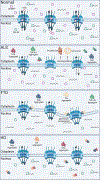Nuclear pore complex and nucleocytoplasmic transport disruption in neurodegeneration
- PMID: 37657945
- PMCID: PMC10612469
- DOI: 10.1002/1873-3468.14729
Nuclear pore complex and nucleocytoplasmic transport disruption in neurodegeneration
Abstract
Nuclear pore complexes (NPCs) play a critical role in maintaining the equilibrium between the nucleus and cytoplasm, enabling bidirectional transport across the nuclear envelope, and are essential for proper nuclear organization and gene regulation. Perturbations in the regulatory mechanisms governing NPCs and nuclear envelope homeostasis have been implicated in the pathogenesis of several neurodegenerative diseases. The ESCRT-III pathway emerges as a critical player in the surveillance and preservation of well-assembled, functional NPCs, as well as nuclear envelope sealing. Recent studies have provided insights into the involvement of nuclear ESCRT-III in the selective reduction of specific nucleoporins associated with neurodegenerative pathologies. Thus, maintaining quality control of the nuclear envelope and NPCs represents a pivotal element in the pathological cascade leading to neurodegenerative diseases. This review describes the constituents of the nuclear-cytoplasmic transport machinery, encompassing the nuclear envelope, NPC, and ESCRT proteins, and how their structural and functional alterations contribute to the development of neurodegenerative diseases.
Keywords: ALS; ESCRT; FTD; neurodegeneration; nuclear pore complex; nucleocytoplasmic transport; nucleoporins.
© 2023 Federation of European Biochemical Societies.
Conflict of interest statement
Declaration of Interest
The authors declare no competing interests.
Figures

Similar articles
-
Nuclear pore and nucleocytoplasmic transport impairment in oxidative stress-induced neurodegeneration: relevance to molecular mechanisms in Pathogenesis of Parkinson's and other related neurodegenerative diseases.Mol Neurodegener. 2024 Nov 23;19(1):87. doi: 10.1186/s13024-024-00774-0. Mol Neurodegener. 2024. PMID: 39578912 Free PMC article. Review.
-
Nuclear Envelope and Nuclear Pore Complexes in Neurodegenerative Diseases-New Perspectives for Therapeutic Interventions.Mol Neurobiol. 2021 Mar;58(3):983-995. doi: 10.1007/s12035-020-02168-x. Epub 2020 Oct 17. Mol Neurobiol. 2021. PMID: 33067781 Free PMC article. Review.
-
Nucleoporins are degraded via upregulation of ESCRT-III/Vps4 complex in Drosophila models of C9-ALS/FTD.Cell Rep. 2022 Sep 20;40(12):111379. doi: 10.1016/j.celrep.2022.111379. Cell Rep. 2022. PMID: 36130523 Free PMC article.
-
Nuclear pore complex composition: a new regulator of tissue-specific and developmental functions.Nat Rev Mol Cell Biol. 2012 Nov;13(11):687-99. doi: 10.1038/nrm3461. Nat Rev Mol Cell Biol. 2012. PMID: 23090414 Review.
-
ESCRTs breach the nuclear border.Nucleus. 2015;6(3):197-202. doi: 10.1080/19491034.2015.1035844. Epub 2015 May 5. Nucleus. 2015. PMID: 25942571 Free PMC article.
Cited by
-
Cytoplasmic nucleoporin assemblage: the cellular artwork in physiology and disease.Nucleus. 2024 Dec;15(1):2387534. doi: 10.1080/19491034.2024.2387534. Epub 2024 Aug 12. Nucleus. 2024. PMID: 39135336 Free PMC article. Review.
-
Nuclear pore and nucleocytoplasmic transport impairment in oxidative stress-induced neurodegeneration: relevance to molecular mechanisms in Pathogenesis of Parkinson's and other related neurodegenerative diseases.Mol Neurodegener. 2024 Nov 23;19(1):87. doi: 10.1186/s13024-024-00774-0. Mol Neurodegener. 2024. PMID: 39578912 Free PMC article. Review.
-
The nuclear envelope and nuclear pore complexes in neurodegenerative diseases.Front Cell Dev Biol. 2025 May 13;13:1550859. doi: 10.3389/fcell.2025.1550859. eCollection 2025. Front Cell Dev Biol. 2025. PMID: 40433544 Free PMC article. Review.
-
Nuclear and degradative functions of the ESCRT-III pathway: implications for neurodegenerative disease.Nucleus. 2024 Dec;15(1):2349085. doi: 10.1080/19491034.2024.2349085. Epub 2024 May 3. Nucleus. 2024. PMID: 38700207 Free PMC article. Review.
-
Heterogeneous Nuclear Ribonucleoprotein A1 Knockdown Alters Constituents of Nucleocytoplasmic Transport.Brain Sci. 2024 Oct 19;14(10):1039. doi: 10.3390/brainsci14101039. Brain Sci. 2024. PMID: 39452051 Free PMC article.
References
-
- Alber F, Dokudovskaya S, Veenhoff LM, Zhang W, Kipper J, Devos D, Suprapto A, Karni-Schmidt O, Williams R, Chait BT, Sali A & Rout MP (2007) The molecular architecture of the nuclear pore complex, Nature. 450, 695–701. - PubMed
-
- Beck M & Hurt E (2017) The nuclear pore complex: understanding its function through structural insight, Nature reviews Molecular cell biology. 18, 73–89. - PubMed
-
- Dickmanns A, Kehlenbach RH & Fahrenkrog B (2015) Nuclear Pore Complexes and Nucleocytoplasmic Transport: From Structure to Function to Disease, International review of cell and molecular biology. 320, 171–233. - PubMed
-
- Hampoelz B, Andres-Pons A, Kastritis P & Beck M (2019) Structure and Assembly of the Nuclear Pore Complex, Annual review of biophysics. - PubMed
Publication types
MeSH terms
Substances
Grants and funding
LinkOut - more resources
Full Text Sources
Medical
Miscellaneous

